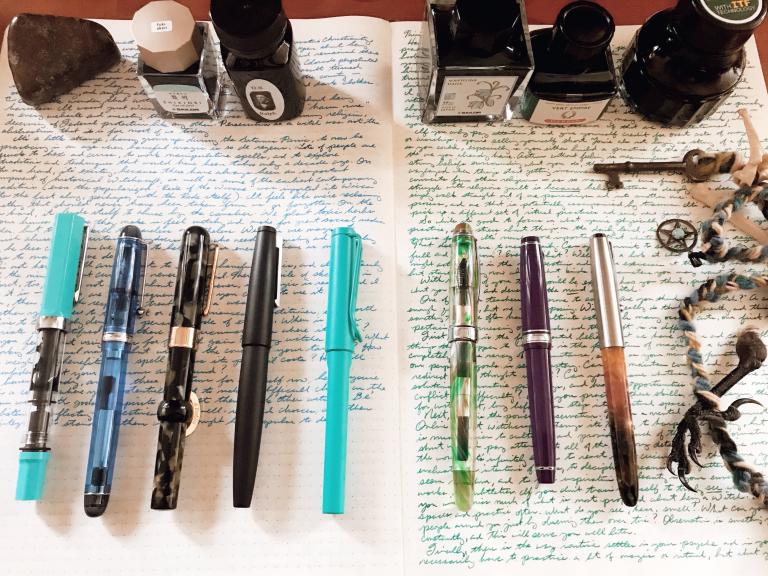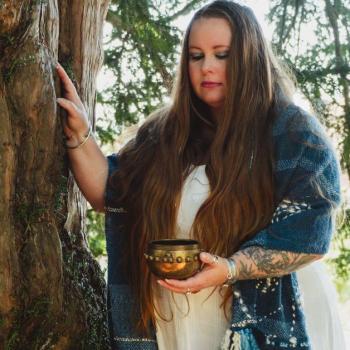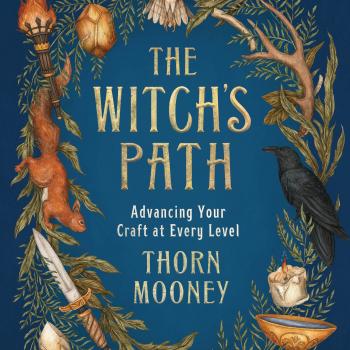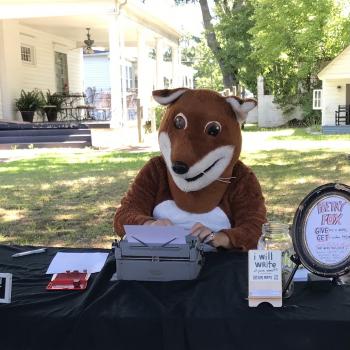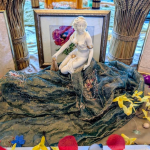It often surprises people to learn that I write my books and blogs by hand. Computers and phones have become so ubiquitous that I think it just doesn’t occur to us that this might be an option that some writers still choose—it sounds so antiquated and needlessly difficult. Maybe even pretentious. I admit that I was inspired to give it a try after hearing that this is how Neil Gaiman writes his novels, and because I once had the privilege to see the original manuscript of Dickens’s Oliver Twist, and I literally wept like a giant nerd (In public! Surrounded by worried colleagues and friends!). I had a similar reaction to seeing Ray Buckland’s beat-up wirebound notebook at the Buckland Museum a few years ago, containing the earliest draft of his Complete Book of Witchcraft (not to compare Buckland to Dickens, but both have been instrumental in the course of my life for very different reasons).
Like, holy shit, friends, people used to have to write everything by hand. I think that’s incredible. I remember learning about monks and illuminated manuscripts in middle school and thinking, “I want that job.” Being a Gardnerian—with our penchant for hand-copying the Book of Shadows and writing our own over the course of our lives—is about as close as I could manage.
Obviously not having to hand write things is a huge blessing, and I’m not saying that everyone needs to write by hand in order to be magical or engage with magical text. You definitely don’t. I know plenty of folks who keep their records and write their books by other means, and as a classroom teacher I spent most of my time making reading and writing as accessible as possible to students with different needs, and that often meant eliminating conventional ideas about pen and paper. By all means (and my upcoming book, The Witch’s Path, discusses some of these alternative strategies for those of you who struggle with keeping magical records and journals).
But the relationship between pen, ink, and paper is holy to me, and I just felt the need to gush at you all for a minute.
An Ode to Fountain Pens
My life changed with my first fountain pen, and I’m not exaggerating in the least. I bought it on a whim, at the recommendation of a friend who was surprised I wasn’t already an enthusiast. Truthfully, I’d sort of consciously not purchased a fountain pen at that point because I have zero chill, am incapable of moderation, and knew that I would immediately start hemorrhaging money. I was correct, not so much because it has to be expensive, but because I quickly deprioritized basically everything else so that I could indulge myself. Some people love gourmet food and fine clothes and the latest smart phone. I love a gold flex nib.
Fountain pens are wonderful no matter what level of interest you have because of their versatility. You can choose your ink, you can choose you nib, you can choose your grip, you can choose what’s most comfortable for you. As a witch, it’s a very magical experience to have so much control over an implement that comes to feel like a friend in your Work. We often take a lot of care to choose our athames and wands…why not the pen we use to write in our magical books and to take notes as we learn from others? You’ll probably spend more time with your pen than you will your ritual sword, so why not choose one with just as much care (even if it’s not a fountain pen)?
Throughout my life as a teacher (from teaching guitar, to teaching tarot, to teaching English and writing) I’ve found over and over again that students who love the tools they’re using are more likely to practice. If your guitar is too big for you and the strings are too high off the fretboard so that your fingers hurt when you play, you won’t practice as much as you should. If you hate your tarot deck because you think the art is ugly or the cards are too big to shuffle, you won’t read with it as often (you might even decide you don’t like tarot).
People are often pleasantly surprised to discover that the real reason they don’t like writing and can’t manage to keep a journal (or think their handwriting sucks) is because they’re using shitty tools. All pens are not equal. All paper is not equal. All ink is not equal. I can’t write for long with a ballpoint, either, my friends. Because those tiny muscles in my hand don’t like having to put pressure on a pen for that long to make it work (fountain pens work by capillary action, drawing ink down onto the paper simply by touching it, rather than by putting pressure on the pen). And my handwriting is worse if I’m trying to use one, especially on paper that’s too rough.
I love the color variety that’s available, and the qualities of the different inks. I love how my cursive magically became better, because I was using more appropriate technology (fountain pens are designed to make continuous contact with paper and use thinner ink—ballpoints are much less efficient where cursive is concerned, which equals worse cursive). My magical books became beautiful instead of simply utilitarian. The end result was that I now use them daily instead of just intermittently.
Getting away from a screen also makes for less distraction for me. The glare of my laptop and my phone gives me headaches and makes me anxious, and the temptation to surf the Internet is a little too overwhelming. With a pen and notebook, I can go anywhere, don’t have to find an outlet, and don’t have to worry about lost time or strained eyes. The added bonus is that I don’t have to do very much editing or proofreading, because when I type up the handwritten draft, I catch my errors and have the opportunity to rephrase things. It takes me more time to write a longer project, but I’m a copyeditor’s dream. It’s a fair trade-off to me!
Some Ideas for Making Writing Magical
- No matter what kind of writing utensils you choose, consider consecrating them. I remember blessing my pencil before taking exams in school, courtesy of some spell I found in a witchcraft book for teens (probably Teen Witch, but really I think something similar was in all of them). I never really stopped doing that sort of thing. Magic your pen like you would any other tool, and then make it work for you! Give it a name, like you would a blade. Paint sigils on it. Bless it alongside of your crystals or your tarot cards. Make it magic, and then surprise yourself with how much more satisfying it is to use.
- Make magical ink! You can find lots of recipes for botanical inks with a search online (here in the south it’s common to use pokeberries or walnuts—both are messy but fun projects), but if you want to keep it simple, I recommend spelling whatever bottles of ink you might already have. Fountain pens require special inks intended for them, so you can’t just load up whatever you’ve concocted on your stovetop without clogging the feed (I recommend dip pens for your homemade projects), but you can start with fountain pen ink and then magically charge it. Add a drop of an essential oil, enchant a small stone to keep in the bottle, paint a sigil on the lid. Get creative! I have inks that I use specifically for working petition magic, inks for copying magical text from other sources, and inks for writing my books.
- Consider researching deities associated with writing and recordkeeping. I have a statue of Thoth on my work desk and he’s become important to me as I’ve grown as a writer. Even if you aren’t interested in working with gods (or another god), it can be inspiring to learn about how writing has been held sacred throughout history and in different cultural settings. We’re living in a time where literacy is still a privilege reserved for the wealthy. Until very recently it was a crime for certain people to be allowed to read, write, and own books. Even today, we deny comprehensive reading education to children throughout the United States, especially in impoverished areas (which most heavily impacts BIPOC children). Literacy is sacred, and fewer people have access than we like to imagine. It’s not something we should ever take for granted.
Your First Fountain Pen
My go-to recommendation is the Lamy Safari or AL-Star (same as the Safari, but an aluminum instead of plastic body). You can score one for between $20-$40, and then choose whether you’d like to use cartridges or buy a converter and fill it with your own bottled ink (I recommend giving both a whirl—I rend to use a converter, but will sometimes switch to a cartridge when I travel). They also come in tons of colors, and have interchangeable nibs. If you want to go from fine to broad or try cursive italic (so fancy!), you can buy a nib instead of a whole new pen.
You can pretty much choose whatever sort of ink looks fun to you, but my go-to brands are Noodler’s, Diamine, and Sailor. One of my favorites of all time is called Nightshade–how witchy is that? Note that if you pick one with glitter in it, you’re more likely to clog your pen if you don’t use it every day. Not a big deal, just more maintenance. Fountain pens aren’t difficult to clean, and “pen cleaning day” is something I really look forward to, in the same way that I enjoy cleaning and resetting my altar. Some fountain pen vendors will sell you samples, which is nice if you don’t want to commit to a bottle (a bottle of ink can run anywhere from $10 to $40).
My favorite fountain pen shop is, hands down, The Goulet Pen Co. They’re family-owned and based in nearby Virginia. Their website is also packed full of tutorial videos for users at all levels. Their customer service is top, too. For dip pens, quill pens, and related accessories (plus impossibly gorgeous fountain pen friendly journals), I love Arte of the Book (incidentally, also family-owned and based in Virginia–something is clearly in the water). Both companies also have amazing gifts for the writer in your life (or just do what I do and say you’re shopping for other people, but really just keep it all yourself *coughcough*).
A fountain pen can feel like a significant investment at first, but to me it’s been absolutely worth it. It can also be overwhelming, but once you know the basics, all pens pretty much work the same. Those massive price differences are usually about materials (gold vs. steel nibs, fancy body materials vs. plain old plastic, handcrafted vs. mass manufactured), and are not a guarantee that a pen will be comfortable to use.
Finally, be aware that paper plays a strong role, too. Not all paper is suitable for fountain pen use, so when shopping look for an indication that it’s “fountain pen friendly.” My favorites are Rhodia, Leuchtturm1917, Mnemosyne, and Tomoe River. Experiment here!
That’s an awful lot of gushing for one post, but I hope this was helpful. I’m always happy to talk about pens (and to see your favorites!) so please feel free to comment and share on whatever socials you prefer. I’d also love to hear about any practices you may have developed to make writing magical!
Enjoy my writing? Find more at www.patreon.com/thornthewitch and give me a follow on Instagram.

